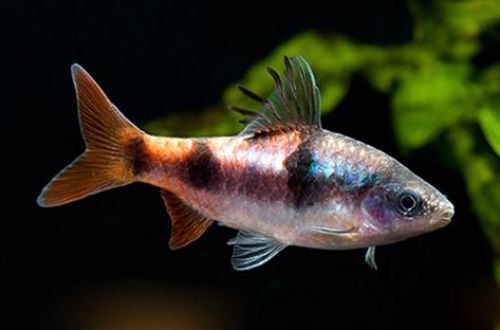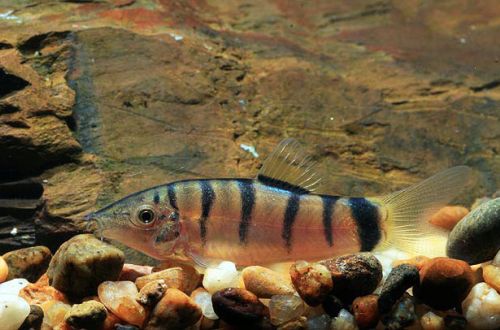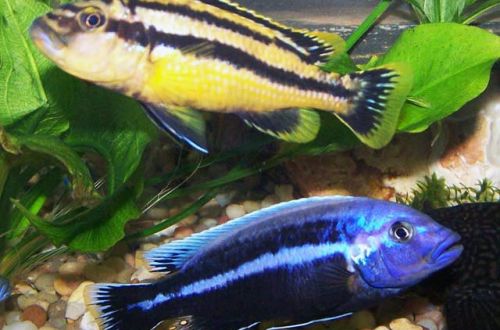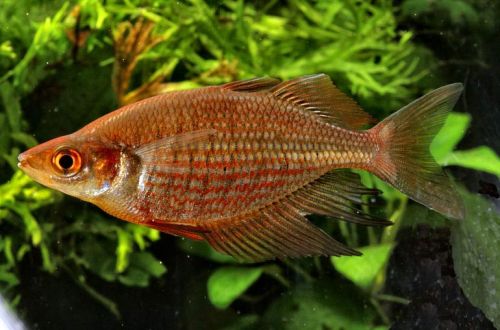
Barbus Tamirabarani
The Tamirabarani barb, scientific name Dawkinsia tambraparniei, belongs to the Cyprinidae family. The fish got its name from the area in which it lives – the Tamirabarani River. Easy to keep and breed, compatible with other similar species. May be recommended for beginner aquarists.

Contents
Habitat
It comes from the southern part of India, from the territory of the state of Tamil. It lives in the basin of the Tamirabarani River, which originates in the Western Ghats and flows into the Gulf of Mannar. The natural habitat is changeable, it is influenced by the season and the area through which the river flows. It can be both fast mountain streams and slow swampy waters of the plains.
Brief information:
- The volume of the aquarium – from 200 liters.
- Temperature – 18-25°C
- Value pH — 6.0–8.0
- Water hardness – 3–15 dGH
- Substrate type — stony
- Lighting – low, moderate
- Brackish water – no
- Water movement – moderate
- The size of the fish is 10–13 cm.
- Feeding – any food of suitable size
- Temperament – peaceful
- Keeping in a group of 8-10 individuals
Description
Adult individuals reach a length of up to 13 cm. The color is silvery with three dark strokes on the sides of the body. The anal fin and tail have a red border. Males, unlike females, are larger and brighter in color, there are emerald shades in the color. A characteristic feature of males are thread-like rays on the dorsal fin and small tubercles-growths on the head that occur during the spawning period.
Food
Accepts most popular aquarium fish foods. The daily diet may consist of dry foods (flakes, granules, etc.) combined with bloodworms, brine shrimp, live/fresh or frozen.
Maintenance and care, arrangement of the aquarium
The optimal size of the aquarium for a small flock of these fish starts from 200 liters. Barbus Tamirabarani, despite the rather diverse habitat, prefers an environment resembling mountain rivers with a flat bottom. In the design, you can use rocky soil with large boulders and several snags. Artificial analogues or live plants of unpretentious species, such as Anubias, as well as aquatic mosses and ferns, are suitable as plants. Lighting is moderate.
Successful keeping depends largely on maintaining high water quality. Mandatory aquarium care procedures are: weekly replacement of part of the water (30-50% of the volume) with fresh water, regular removal of organic waste, equipment maintenance and monitoring of pH / dGH / oxidizability parameters.
Since the fish comes from flowing reservoirs, the presence of an internal current is welcome. Its source may be the filtration system. Some models create quite a strong movement of water.
Behavior and Compatibility
A peaceful schooling fish, compatible with other non-aggressive species of comparable size that can live in similar conditions, such as char. It is recommended to maintain in a group of at least 8-10 individuals. In this case, rare outbreaks of hostility between males that occur in the process of competition for hierarchy in the group will not go beyond the pack.
Breeding / breeding
The breeding process is similar to other cyprinids. With the onset of the mating season, the females scatter the eggs in the water column, and the males fertilize them. Parental instincts are not developed, therefore, immediately after spawning, adult fish can eat their own offspring, which is why the survival rate of juveniles in a common aquarium is minimal.
If you plan to start breeding Tamirabarani Barbs, then to save the fry, you will need to prepare a separate tank with identical water conditions – a spawning aquarium. A small aquarium of 10 liters is enough, equipped with a simple airlift filter with a sponge and a heater. A separate light source is not required. Arrangement is optional.
At the end of spawning, the eggs are transferred to a spawning aquarium prepared in advance. The incubation period lasts 24-48 hours, after another day they begin to swim freely in search of food. Feed with specialized food for juvenile aquarium fish, Artemia nauplii.
Fish diseases
In a balanced aquarium ecosystem with species-specific conditions, diseases rarely occur. Diseases are caused by environmental degradation, contact with sick fish, and injuries. If this could not be avoided, then more about the symptoms and methods of treatment in the section “Diseases of aquarium fish”.





